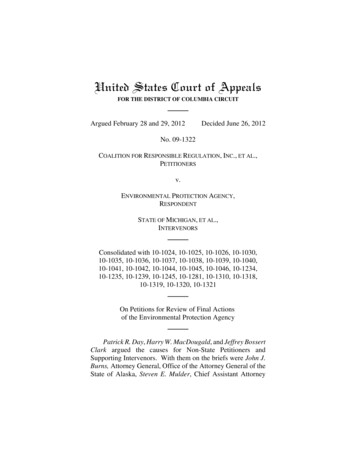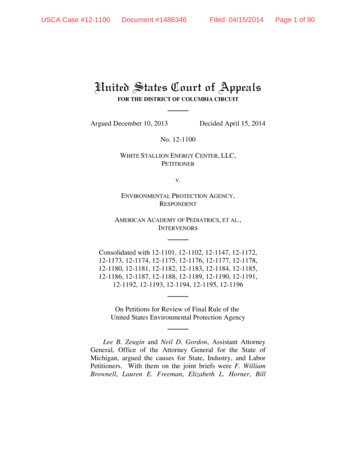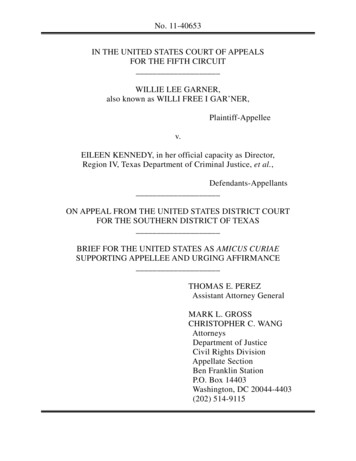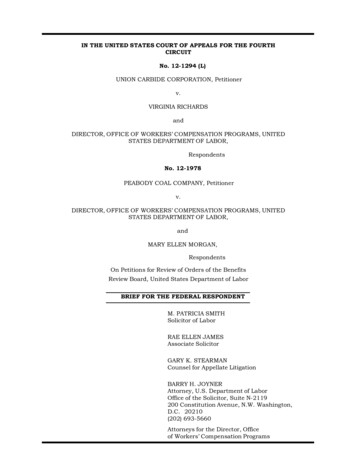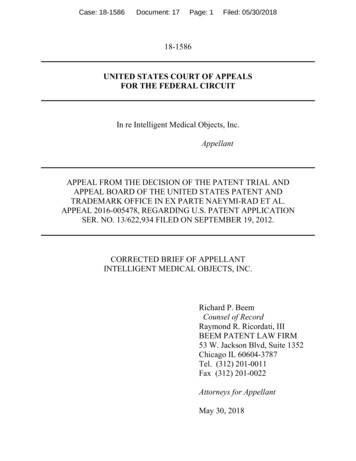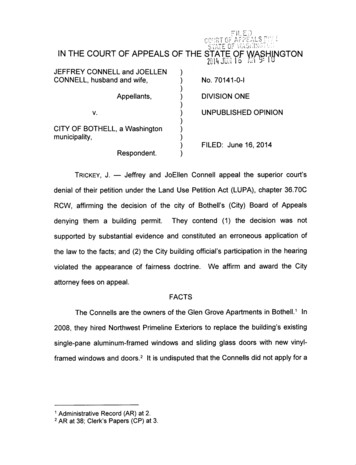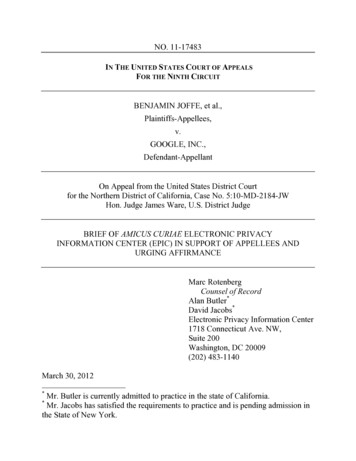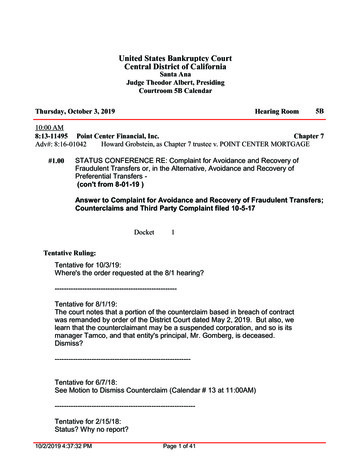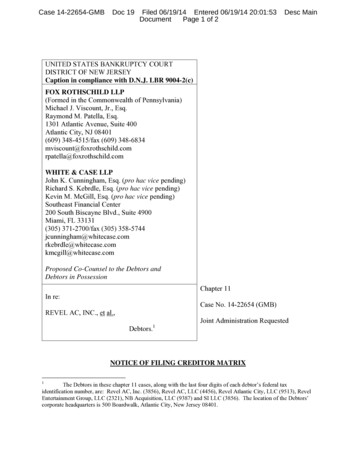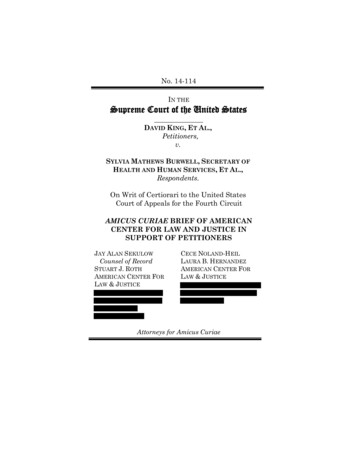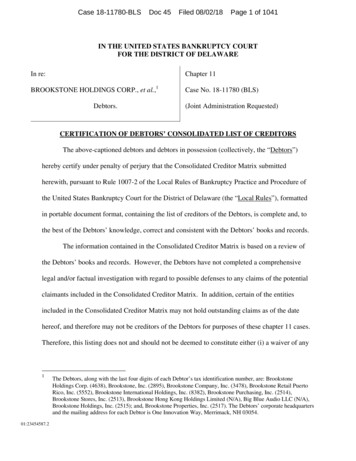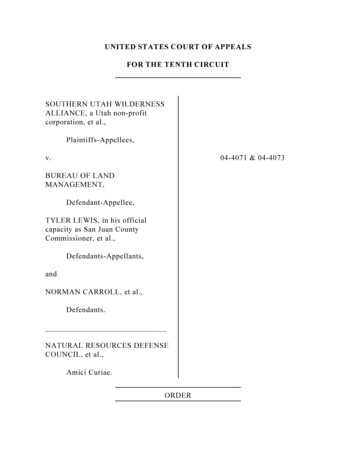
Transcription
UNITED STATES COURT OF APPEALSFOR THE TENTH CIRCUITSOUTHERN UTAH WILDERNESSALLIANCE, a Utah non-profitcorporation, et al.,Plaintiffs-Appellees,v.04-4071 & 04-4073BUREAU OF LANDMANAGEMENT,Defendant-Appellee,TYLER LEWIS, in his officialcapacity as San Juan CountyCommissioner, et al.,Defendants-Appellants,andNORMAN CARROLL, et al.,Defendants.NATURAL RESOURCES DEFENSECOUNCIL, et al.,Amici Curiae.ORDER
Filed January 6, 2006Before HENRY, HARTZ, and McCONNELL, Circuit Judges.These matters are before the court on the petition for rehearing filed onbehalf of Garfield and Kane Counties. Upon consideration of the petition, and theresponses filed by other parties and amici, we have determined to amend theoriginal panel opinion on page 86, to include the following sentence:This case does not raise the question, and we do not decide, whethera road officially laid out or erected for public use by state or localgovernmental authority prior to repeal of R.S. 2477 would qualify asa highway without proof of ten years’ continuous public use. SeeUtah Code Ann. Sec. 72-1-102(7) (West 2004).A copy of the amended opinion is attached to this order. It shall be substitutedfor the original. The petition for panel rehearing is otherwise denied in allrespects.Entered for the Courtby:2Elisabeth A. ShumakerClerk of Court
F I L E DUnited States Court of AppealsTenth CircuitPUBLISHUNITED STATES COURT OF APPEALSTENTH CIRCUITSeptember 8, 2005PATRICK FISHER,Clerk of CourtSOUTHERN UTAH WILDERNESSALLIANCE, a Utah non-profitcorporation, and SIERRA CLUB, anon-profit corporation,v.Plaintiffs-Appellees,BUREAU OF LANDMANAGEMENT,Defendant-Appellee,andSAN JUAN COUNTY, Utah; TYLERLEWIS, in his official capacity as SanJuan County Commissioner; KANECOUNTY, Utah; and GARFIELDCOUNTY, --------NORMAN CARROLL, in hisofficial capacity as Kane CountyCommissioner; JOE JUDD, inhis official capacity as Kane CountyCommissioner; STEPHEN CROSBY,in his official capacity as Kane CountyCommissioner; LOUISE LISTON, inher official capacity as GarfieldCounty Commissioner; D. MALOYNos. 04-4071 & 04-4073
DODDS, in his official capacity asGarfield County Commissioner;CLARE M. RAMSAY, in her officialcapacity as Garfield CountyCommissioner,Defendants.NATURAL RESOURCES DEFENSECOUNCIL, NATIONAL PARKSCONSERVATION ASSOCIATION;THE WILDERNESS SOCIETY;ALASKA CENTER FOR THEENVIRONMENT; ALASKAWILDERNESS LEAGUE; ARIZONAWILDERNESS COALITION;CALIFORNIA WILDERNESSCOALITION; COLORADOENVIRONMENTAL COALITION;COLORADO MOUNTAIN CLUB;GRAND CANYON TRUST;GREATER YELLOWSTONECOALITION; IDAHOCONSERVATION LEAGUE;NATIONAL WILDLIFEFEDERATION; NATIONALWILDLIFE REFUGE ASSOCIATION;NEW MEXICO WILDERNESSALLIANCE; NORTHERN ALASKAENVIRONMENTAL CENTER;SAN JUAN CITIZENS COALITION;SOUTHEAST ALASKACONSERVATION COUNCIL;WYOMING OUTDOOR COUNCIL;PROPERTY OWNERS FORSENSIBLE ROADS POLICY; JANASMITH; RON SMITH; STATES OFUTAH, IDAHO, and WYOMING,2
Amici Curiae.APPEAL FROM THE UNITED STATES DISTRICT COURTFOR THE DISTRICT OF UTAH(D.C. NO. 2:96-CV-836-TC)Shawn T. Welch (Robert S. Thompson, III, with him on the briefs), Pruitt Gushee,Salt Lake City, Utah, for Defendants-Appellants San Juan County and San JuanCounty Commissioner Tyler Lewis.Ralph L. Finlayson, Assistant Attorney General (Mark L. Shurtleff, AttorneyGeneral, with him on the briefs), Salt Lake City, Utah, for Defendants-AppellantsKane and Garfield Counties.Jerome L. Epstein, Jenner & Block LLP, Washington, D.C. (Heidi J. McIntosh,Southern Utah Wilderness Alliance, Salt Lake City, Utah, Edward B. Zukoski,Earthjustice, Denver, Colorado, and William H. Hohengarten, Jenner & BlockLLP, Washington, D.C., with him on the brief), for Plaintiffs-Appellees SouthernUtah Wilderness Alliance and Sierra Club.Todd S. Aagaard, Attorney, Appellate Section, Environment & Natural ResourcesDivision, Department of Justice, Washington, D.C. (Thomas L. Sansonetti,Assistant Attorney General, M. Alice Thurston, Attorney, Appellate Section,Environment & Natural Resources Division, Department of Justice, Washington,D.C., Paul M. Warner, United States Attorney, Salt Lake City, Utah, and DanielD. Price, Assistant United States Attorney, Salt Lake City, Utah, with him on thebrief), for Defendant-Appellee Bureau of Land Management.Mark L. Shurtleff, Utah Attorney General, and J. Mark Ward, Assistant AttorneyGeneral, Salt Lake City, Utah; Steven W. Strack, Deputy Idaho Attorney General,Boise, Idaho; and Patrick J. Crank, Wyoming Attorney General, Cheyenne,Wyoming, filed an amici curiae brief for the states of Utah, Idaho, and Wyoming,in support of Appellants San Juan, Kane, and Garfield Counties.Michael S. Freeman, Faegre & Benson LLP, Denver, Colorado, filed an amicicuriae brief for Property Owners for Sensible Roads Policy and Jana and RonSmith, in support of Appellees Southern Utah Wilderness Alliance, Sierra Club,3
and the Bureau of Land Management.Rebecca L. Bernard, Trustees for Alaska, Anchorage, Alaska, and Louis R.Cohen, James R. Wrathall, and Brian M. Boynton, Wilmer, Cutler, Pickering,Hale & Dorn LLP, Washington, D.C., filed an amici curiae brief for NaturalResources Defense Council, National Parks Conservation Association, TheWilderness Society, Alaska Center for the Environment, Alaska WildernessLeague, Arizona Wilderness Coalition, California Wilderness Coalition, ColoradoEnvironmental Coalition, Colorado Mountain Club, Grand Canyon Trust, GreaterYellowstone Coalition, Idaho Conservation League, National Wildlife Federation,National Wildlife Refugee Association, New Mexico Wilderness Alliance,Northern Alaska Environmental Center, San Juan Citizens Coalition, SoutheastAlaska Conservation Council, and Wyoming Outdoor Council, in support ofPlaintiff-Appellees.Before HENRY, HARTZ, and McCONNELL, Circuit Judges.McCONNELL, Circuit Judge.This case involves one of the more contentious land use issues in the West:the legal status of claims by local governments to rights of way for theconstruction of highways across federal lands managed by the Bureau of LandManagement (BLM). In 1866, Congress passed an open-ended grant of “the rightof way for the construction of highways over public lands, not reserved for publicuses.” Act of July 26, 1866, ch. 262, § 8, 14 Stat. 251, 253, codified at 43 U.S.C.§ 932, repealed by Federal Land Policy Management Act of 1976 (FLPMA),Pub.L. No. 94-579 § 706(a), 90 Stat. 2743. This statute, commonly called “R.S.2477,” remained in effect for 110 years, and most of the transportation routes of4
the West were established under its authority. During that time congressionalpolicy promoted the development of the unreserved public lands and their passageinto private productive hands; R.S. 2477 rights of way were an integral part of thecongressional pro-development lands policy.In 1976, however, Congress abandoned its prior approach to public landsand instituted a preference for retention of the lands in federal ownership, with anincreased emphasis on conservation and preservation. See FLPMA, 43 U.S.C. §1701 et seq. As part of that statutory sea change, Congress repealed R.S. 2477.There could be no new R.S. 2477 rights of way after 1976. But even as Congressrepealed R.S. 2477, it specified that any “valid” R.S. 2477 rights of way “existingon the date of approval of this Act” (October 21, 1976) would continue in effect.Pub. L. No. 94-579 § 701(a), 90 Stat. 2743, 2786 (1976). The statute thus had theeffect of “freezing” R.S. 2477 rights as they were in 1976. Sierra Club v. Hodel,848 F.2d 1068, 1081 (10th Cir. 1988), overruled on other grounds by Village ofLos Ranchos De Albuquerque v. Marsh, 956 F.2d 970, 971 (10th Cir. 1992) (enbanc).The difficulty is in knowing what that means. Unlike any other federalland statute of which we are aware, the establishment of R.S. 2477 rights of wayrequired no administrative formalities: no entry, no application, no license, nopatent, and no deed on the federal side; no formal act of public acceptance on the5
part of the states or localities in whom the right was vested. As the SupremeCourt of Utah noted 75 years ago, R.S. 2477 “‘was a standing offer of a free rightof way over the public domain,’” and the grant may be accepted “without formalaction by public authorities.” Lindsay Land & Live Stock Co. v. Churnos, 285 P.646, 648 (Utah 1929), (quoting Streeter v. Stalnaker, 85 N.W. 47, 48 (Neb.1901)). In its Report to Congress on R.S. 2477: The History and Management ofR.S. 2477 Rights-of-Way Claims on Federal and Other Lands 1 (June 1993), theDepartment of the Interior explained that R.S. 2477 highways “were constructedwithout any approval from the federal government and with no documentation ofthe public land records, so there are few official records documenting the rightof-way or indicating that a highway was constructed on federal land under thisauthority.”To make matters more difficult, parties rarely had an incentive to raise orresolve potential R.S. 2477 issues while the statute was in effect, unless theunderlying land had been patented to a private party. If someone wished totraverse unappropriated public land, he could do so, with or without an R.S. 2477right of way, and given the federal government’s pre-1976 policy of opening anddeveloping the public lands, federal land managers generally had no reason toquestion use of the land for travel. Roads were deemed a good thing. Typicalwas the comment by the great nineteenth-century Michigan jurist, Thomas6
Cooley, that “[s]uch roads facilitate the settlement of the country, and benefit theneighborhood, and in both particulars they further a general policy of the federalgovernment. But they also tend to increase the value of the public lands, and forthis reason are favored.” Flint & P.M. Ry. Co. v. Gordon, 2 N.W. 648, 653(Mich. 1879). Thus, all pre-1976 litigated cases involving contested R.S. 2477claims (and there are dozens) were between private landowners who had obtainedtitle to previously-public land and would-be road users who defended the right tocross private land on what they alleged to be R.S. 2477 rights of way.Now that federal land policy has shifted to retention and conservation,public roads and rights of way in remote areas appear in a different light. Someroads and other rights of way are undoubtedly necessary, but private landownersexpress the fear that expansive R.S. 2477 definitions will undermine their privateproperty rights by allowing strangers to drive vehicles across their ranches andhomesteads. Conservationists and federal land managers worry that vehicle use ininappropriate locations can permanently scar the land, destroy solitude, impairwilderness, endanger archeological and natural features, and generally make itdifficult or impossible for land managers to carry out their statutory duties toprotect the lands from “unnecessary or undue degradation.” FLPMA § 302(b), 43U.S.C. § 1732(b). They argue that too loose an interpretation of R.S. 2477 willconjure into existence rights of way where none existed before, turning every7
path, vehicle track, or dry wash in southern Utah into a potential route for cars,jeeps, or off-road vehicles. For their part, the Counties assert that R.S. 2477rights of way are “major components of the transportation systems of westernstates,” and express the fear that federal land managers and conservationists areattempting to redefine those rights out of existence, with serious “financial andother impacts” on the people of Utah. Kane and Garfield County (K&G C.) Rep.Br. 21. Thus, the definition of R.S. 2477 rights of way across federal land, whichused to be a non-issue, has become a flash point, and litigants are driven to thehistorical archives for documentation of matters no one had reason to document atthe time.I.FACTUAL AND PROCEDURAL BACKGROUNDIn September and October of 1996, road crews employed by San Juan,Kane, and Garfield Counties entered public lands managed by the BLM andgraded sixteen roads (or “primitive trails,” as the BLM calls them) located insouthern Utah. The Counties did not notify the BLM in advance, or obtainpermission to conduct their road grading activities. With a few possibleexceptions, none of these roads had previously been graded by the Counties,though some of them showed signs of previous construction or maintenanceactivity. The roads are claimed by the Counties as rights of way under R.S. 2477;some of them are listed on County maps as Class B or Class D highways. Six of8
the routes lie within wilderness study areas. Nine are within the Grand StaircaseEscalante National Monument. Six others traverse a mesa overlooking theentrance corridor to the Needles District of Canyonlands National Park.According to the Complaint filed by a consortium of environmental organizationsincluding the Southern Utah Wilderness Alliance (hereinafter collectively referredto as “SUWA”), the areas affected by the Counties’ road grading activities“contain stunning red-rock canyon formations, pristine wilderness areas,important cultural and archeological sits [sic], undisturbed wildlife habitat, andsignificant opportunities for hiking, backpacking and nature study in an arealargely undisturbed by road or human . . . development.”SUWA protested to the BLM, but these initial protests resulted in noapparent action against the road grading actions of the Counties. In October of1996, SUWA filed suit against the BLM, San Juan County, and later Kane andGarfield Counties, alleging that the Counties had engaged in unlawful roadconstruction activities and that the BLM had violated its duties under FLPMA, 43U.S.C. § 1701 et seq., the Antiquities Act, 16 U.S.C. § 431 et seq., and theNational Environmental Policy Act, 42 U.S.C. § 4321 et seq., by not takingaction. The complaint sought declaratory and injunctive relief requiring the BLMto halt the Counties’ construction activities and enjoining the Counties fromfurther road construction or maintenance without the BLM’s permis
TYLER LEWIS, in his official capacity as San Juan County Commissioner, et al., Defendants-Appellants, and NORMAN CARROLL, et al., Defendants. _ NATURAL RESOURCES DEFENSE COUNCIL, et al., Amici Curiae. 04-4071 & 04-4073 ORDER. 2 Filed January 6, 2006 Before HENRY , HARTZ , and McCONNELL , Circuit Judges. These matters are before the court on the petition for rehearing filed on
